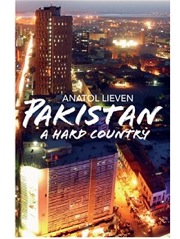In the wake of Osama bin Laden’s execution by American troops, reading Anatol Lieven’s study on Pakistan entitled ‘Pakistan, A Hard Country’ makes for compelling reading. As the United States continues to demand answers from Pakistan, Lieven at the outset states that Pakistan’s support to the United States in the ‘war on terror’ would always be hedged with limitations:
“…neither the Pakistani army, nor the Pakistani state, nor the great majority of Pakistanis will ever give more than very qualified help to the US campaign against the Afghan Taleban, since Pakistanis of every rank and class see these in a quite different light from Al Qaeda and the Pakistani Taleban.”
With Pakistan being continuously undermined for not doing enough in the ‘war on terror’, Lieven points out that while Pakistan may have just been a partial ally in this war, the country has nevertheless played a vital role in providing intelligence to preempt terrorist attacks in the West:
“The help of Pakistani intelligence services to Britain has been absolutely vital to identifying the links of these potential terrorists to groups in Pakistan, and to preventing more attacks on Britain, the USA and Europe.”
Pakistan has been caught in an endless cycle of violence as terror attacks have continued unabated for the last few years. Lieven writes that in 2009, armed militant groups including the Taleban and the Lashkar-e-Jhangvi contributed greatly to the spread of terrorism from the Pathan areas to the Punjab with attacks on high-profile military targets in Lahore.
Leiven dispels the popular misconception that the proliferation of madrasahs has contributed to the spread of terrorism:
“Western officials have often attributed the recruitment of militants in Pakistan to the enormous increase in the number of madrasahs (religious schools) during and after the Afghan war. This, however, seems to be in part a mistake. A majority of known Pakistani terrorists have in fact attended government schools and quite often have a degree of higher education – reflecting yet again the basis for Islamism in the urban lower middle classes rather than the impoverished masses…A very large number of ordinary Taleban fighters have had no education at all, and their recruitment owes less to specific Taleban education than to the general atmosphere prevailing in their villages. Concentration on the role of madrasahs by Western policy-makers is not wholly mistaken, but it nonetheless reflects a very widespread mistake in Western analysis: namely, the tendency to look at Islamist groups and their strategies as instruments which can be isolated and eliminated, rather than phenomena deeply rooted in the societies from which they spring.”
Interestingly, Lieven’s most dangerous encounter during his time in Pakistan involved US forces rather than the armed militant groups. He recounts:
“The most dangerous moments in my visits to Pakistan since 9/11 came in August/September 2008, when on two occasions US forces entered Pakistan’s tribal areas on the ground in order to raid suspected Taleban and Al Qaeda bases. On the second occasion, Pakistani soldiers fired in the air to turn the Americans back. On 19 September 2008 the chief of army staff, General Kayani, flew to meet the US chief of the joint staffs, Admiral Mike Mullen, on the US aircraft carrier USS Abraham Lincoln , and in the words of senior Pakistani general ‘gave him the toughest possible warning’ about what would happen if this were repeated.”
In his chapter on the Pakistani Taleban, Lieven provides an in-depth analysis of the emergence and formation of the Pakistani Taleban. He explains the alliance forged between Al Qaeda and the Taleban:
“Al Qaeda ingratiated themselves with the Taleban partly through ideological affinity (and the prestige which Arab origins have long possessed in this part of the world); partly thorough money; and partly because they came to serve as shock troops for the Taleban in their campaigns in northern Afghanistan, where many of their Pathan troops were unwilling to fight.”
Following the discovery of Osama bin Laden in Abbotabad just a short distance from the capital, Pakistan finds itself at the dawn of a new and unsettling age. With the blame falling squarely on Pakistan for Osama bin Laden’s ability to elude US forces for over a decade and a precipitous loss of confidence in the Pakistan army, Lieven highlights the role of Afghan troops in facilitating the entry of Al Qaeda leaders into Pakistan:
“It is not known how exactly Osama bin Laden, Aiman al Zawahiri and other Al Qaeda leaders were able to escape into Pakistan. If Pakistani troops were lax or complicit, so too were the Afghan troops on either side of the Durand Line to control one of the most rugged frontiers of the world.”
He warns against too much pressure and humiliation being heaped upon Pakistan as this would have disastrous consequences for a population already outraged by US drone attacks which have resulted in the deaths of countless innocent men, women and children.
Rather than discussing terrorism in a general sense, he differentiates between the various terrorist groups operating in Pakistan and their distinctive ideologies. His earlier chapters provide an informative and comprehensive historical account of Pakistani politics, culture and society. Lieven demonstrates his nuanced understanding of a diverse and complex country and tackles difficult subjects with forensic clarity and an unrivalled grasp of detail.






